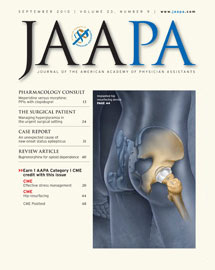Health Care Reform: Is There a Doctor in the House?
September 10, 2010WEDNESDAY, Sept. 8 (HealthDay News) -- Health reform will put insurance cards in the hands of tens of millions of previously uninsured Americans. Many will need physicals, immunizations, preventive screening tests and care for chronic health conditions.
So, how tough will it be to get a doctor's appointment?
Some experts worry that there could be longer wait times to see a doctor, particularly in rural areas and underserved markets where primary-care physicians are in short supply.
"The reality is there's going to be a potential primary-care crisis as health care is expanded," said Dr. John D. Goodson, an internist in primary care at Massachusetts General Hospital and an associate professor of medicine at Harvard Medical School in Boston.
A primary-care practice is often a patient's first and ongoing contact with the medical system. Primary-care physicians are generalists trained in family medicine, general internal medicine or general pediatrics. They diagnose and treat acute and chronic conditions, provide preventive services and counseling, coordinate care and make necessary referrals to specialists.
Yet primary-care physicians make up only 35 percent of America's physician workforce, and the pipeline of fresh talent is tapering off. Fewer than 20 percent of U.S. medical students are choosing to practice primary-care medicine, according to the Council on Graduate Medical Education, which advises and makes recommendations to the U.S. Department of Health and Human Services and Congress on physician workforce matters.
Studies project a shortage of 44,000 to 46,000 primary-care doctors by 2025 unless action is taken to lure more medical students into the field and retain experienced primary-care doctors.
And future demand for generalist physicians is expected to swell as the population ages.
"You can put people in the health insurance plans, but if you don't have enough providers to take care of these people, I think that the system will not work," said Janet Selway, president-elect of the American College of Nurse Practitioners, who sees an expanded role for nurses with advanced education and training.
Further muddying the outlook for the future, a new study estimates that more than half of the 354 million annual doctor visits for so-called acute medical care -- for problems like fevers, stomach aches and coughs -- are not made to a patient's primary-care physician, and that more than 25 percent of such visits take place in hospital emergency rooms. The authors of the study, published Tuesday in the journal Health Affairs, said the findings underscore a big concern about the new health reform legislation: can access to primary-care doctors be maintained, much less improved, when the nation's health-care system takes on 32 million newly insured customers starting in 2014?, The New York Times reported.
Massachusetts experienced a shortage of primary-care physicians in the wake of the commonwealth's universal health insurance law, which was enacted in 2006. But it had only two years to prepare for the onslaught of patients. The full impact of the federal health reform law won't be felt until 2019.
The Patient Protection and Affordable Care Act -- the sweeping health reform bill signed into law by President Barack Obama in March -- includes a number of programs to strengthen primary-care. But is it enough?
In a "Perspective" article published in the Annals of Internal Medicine in April, Goodson argued that, to avert a primary-care crisis, medical schools must prioritize and support primary-care training, and policymakers have to do something about the nation's lopsided physician reimbursement system, which favors specialists.
"The starting pay for a radiologist coming out of a training program could be $400,000 to $500,000 a year, whereas a trainee coming out of a general medicine program or a family medicine program could be $150,000 a year," he told HealthDay. "I mean, this is just patently absurd."
Goodson and other primary-care advocates also see the need for a better way to take care of patients' acute and chronic health-care needs without burning out doctors.
One potential solution is a team-based model of care called the "medical home." In a medical home, every patient has a personal physician. But instead of acting alone, the physician leads a cadre of non-physician providers. The team may include physician assistants, nurse practitioners and others who are responsible for coordinating patient care.
"In many ways, it's the ideal incarnation what you wish you primary-care physician -- what he or she -- would be able to do to support your care," said Susan Stuard, executive director of the Taconic Health Information Network and Community, a partner in the Hudson Valley Initiative, an effort to improve health-care delivery in six New York counties.
Stuard's organization has helped more than 600 Hudson Valley-area primary-care physicians, including a number of solo and small practices, implement electronic health records. Having information technology in place to coordinate care, avoid repetitive lab tests and ensure timely screenings is a key component of the medical home concept, she said.
Group Health Cooperative in Seattle, an early adopter of the medical home model, recently published results of a pilot program comparing the medical home experience at one clinic with its other practice sites. After two years, patients in the medical home had better experiences and better quality of care, and physicians reported less workplace stress. The study was published in the May issue of Health Affairs.
However, results of a two-year medical home experiment involving 36 primary-care practices across the country found small improvements in quality of care but not in patient experiences. That study appeared in a special supplement to the May/June issue of the Annals of Family Medicine.
"The issue with the medical home is, how it can be done in a way that's really going to serve the needs of the patient best," Goodson said.
More information
The Patient-Centered Primary Care Collaborative has more on the medical home model.
To read the first part of the series click here.
SOURCES: John D. Goodson, M.D., internist, primary care, Massachusetts General Hospital, and associate professor, medicine, Harvard Medical School, Boston; Janet Selway, D.N.Sc., C.R.N.P., president-elect, American College of Nurse Practitioners, Arlington, Va., Susan Stuard, M.B.A., executive director, Taconic Health Information Network and Community, Fishkill, N.Y.; American Academy of Family Physicians (www.aafp.org); Sept. 7, 2010, The New York Times; Council on Graduate Medical Education, May 5, 2009, letter; April 19, 2010, Annals of Internal Medicine; May 2010, Health Affairs; May/June 2010, Annals of Family Medicine
Copyright © 2010 HealthDay. All rights reserved.
Posted by J H. Posted In : Health Care Reform


